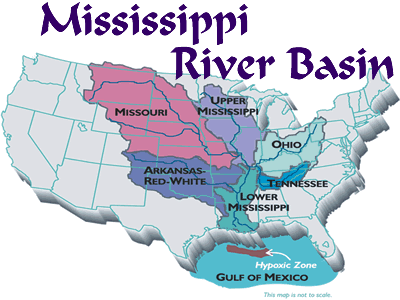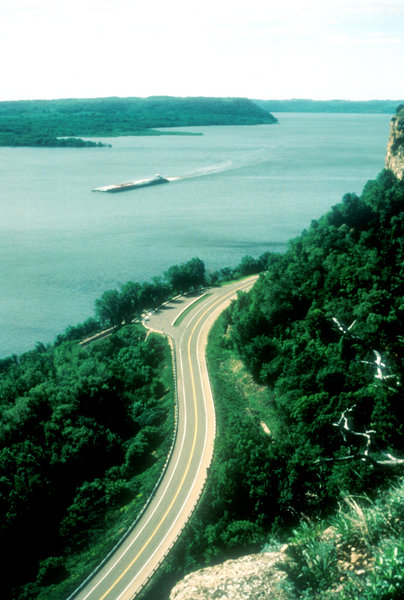
The Mississippi River
The Mississippi River is the second-longest river in the United States; the longest is the Missouri River, which flows into the Mississippi. Taken together, they form the largest river system in North America. If measured from the head of the Missouri, the length of the Missouri/Mississippi combination is approximately 3,895 miles (6,270 km) long.
With its source Lake Itasca at 1475 feet (450 m) above sea level in Itasca State Park in northern Minnesota, the river falls to 725 feet (220 m) just below Saint Anthony Falls in Minneapolis. The Mississippi is joined by the Illinois River and the Missouri River at Saint Louis, and by the Ohio at Cairo, Illinois. The Arkansas River joins the Mississippi in the state of Arkansas. The Atchafalaya River in Louisiana is a major distributary of the Mississippi.

The Mississippi River, looking south toward the city of St. Louis.(courtesy USGS)
The Mississippi drains most of the area between the Rocky Mountains and the Appalachian Mountains, except for the area drained by the Great Lakes. It runs through, or borders, ten states in the United States -- Minnesota, Wisconsin, Iowa, Illinois, Missouri, Kentucky, Arkansas, Tennessee, Mississippi and Louisiana -- before emptying into the Gulf of Mexico about 100 miles (160 km) downstream from New Orleans. Measurements of the length of the Mississippi from Lake Itasca to the Gulf of Mexico vary, but the EPA's number is 2,320 miles (3733 km). A raindrop falling in Lake Itasca would arrive at the Gulf of Mexico in about 90 days.
The river is divided into the upper Mississippi, from its source south to the Ohio River, and the lower Mississippi, from the Ohio to its mouth near New Orleans. The upper Mississippi is further divided into three sections: the headwaters, from the source to Saint Anthony Falls; a series of man-made lakes between Minneapolis and St. Louis; and the middle Mississippi, a relatively free-flowing river downstream of the confluence with the Missouri River at St. Louis.
A series of 27 locks and dams on the upper Mississippi, most of which were built in the 1930s, is designed primarily to maintain a 9 foot (2.7 m) channel for commercial barge traffic. The lakes formed are also used for recreational boating and fishing. The dams make the river deeper and wider but do not stop it. No flood control is intended. During periods of high flow, the gates, some of which are submersible, are completely opened and the dams simply cease to function. Below St. Louis the Mississippi is relatively free-flowing, although it is constrained by numerous levees and directed by numerous wing dams.
The mouth of the Mississippi River has shifted repeatedly over time. Since a canal was built in the early nineteenth century, the river has been seeking the Atchafalaya River mouth, some 60 miles (95 km) from New Orleans. The U.S. Army Corps of Engineers maintains a massive system of locks to keep the river in its present course.

Map of Mississippi River drainage basin(courtesy US EPA)
Other changes in the course of the river have occurred because of earthquakes along the New Madrid Fault Zone, which lies near the cities of Memphis and St. Louis. Three earthquakes in 1811 and 1812, estimated at approximately 8 on the Richter Scale, were said to have temporarily reversed the course of the Mississippi. These earthquakes also created Reelfoot Lake in Tennessee from the altered landscape near the river. The faulting is related to an aulacogen (geologic term for a failed rift) that formed at the same time as the Gulf of Mexico.
The Mississippi River has the third largest drainage basin in the world, exceeded in size only by the watersheds of the Amazon River and Congo River. It drains 41 percent of the 48 contiguous states of the United States. The basin covers more than 1,245,000 square miles (3,225,000 km²), including all or parts of 31 states and two Canadian provinces.
The word Mississippi comes from the Ojibwe name for the river, "Messipi", which means big river, or from the Algonquin Missi Sepe, "great river," literally, "father of waters." On May 8, 1541 Hernando de Soto became the first recorded white man to reach the Mississippi River, which he called "Rio de Espiritu Santo" (River of the Holy Spirit). French explorers Louis Joliet and Jacques Marquette began exploring the Mississippi, which they knew by the Sioux name "Ne Tongo" (which, like the Ojibwe name, means big river), on May 17, 1673. In 1682, René Robert Cavelier, Sieur de La Salle and Henri de Tonty claimed the entire Mississippi River Valley for France, calling it Louisiana, for King Louis XIV.
France lost all its territories on the mainland of North America as a result of the French and Indian War. The Treaty of Paris (1763) gave England rights to all land in the valley east of the Mississippi, and Spain rights to land west of the Mississippi. France re-acquired 'Louisiana' in the secret Treaty of San Ildefonso in 1800. The United States bought the territory from France in the Louisiana Purchase of 1803.
In 1900, Chicago built the Chicago Sanitary and Ship Canal to link the Great Lakes to the Mississippi. The canal allowed Chicago to flush its waste down the Mississippi rather than having it pollute its own Lake Michigan waterfront. The canal also provided a shipping route between the Great Lakes and the Mississippi.
In the spring of 1927 the river broke out of its banks in 145 places during the Great Mississippi Flood of 1927 and inundated 27,000 square miles (70,000 km²) to a depth of up to 30 feet (10 m). The Great Flood of 1993 is considered the most devastating flood to occur in the U.S. in modern history.
The task of maintaining a navigation channel on the Mississippi is the responsibility of the U.S. Army Corps of Engineers, which began as early as 1829 removing snags, closing off secondary channels and excavating rocks and sandbars. In 1829 the Corps surveyed the two major obstacles on the upper Mississippi, the Des Moines Rapids and the Rock Island Rapids, where the river was shallow and the riverbed was rock. The Des Moines Rapids were about 11 miles (18 km) long and just above the mouth of the Des Moines River at Keokuk. The Rock Island Rapids were between Rock Island and Moline. Both rapids were considered virtually impassable.

Wisconsin Great River Road, Mississippi River, and bluffs.
The Corps recommended excavation of a 5 foot (1.5 m) channel at the Des Moines Rapids, but work didn't begin until after Lieutenant Robert E. Lee endorsed the project in 1837. The Corps later also began excavating the Rock Island Rapids. By 1866 it had become evident that excavation was impractical, and it was decided to build a canal around the Des Moines Rapids. The canal opened in 1877, but the Rock Island Rapids remained an obstacle.
In 1878, Congress authorized the Corps to establish a 4 ½ foot (1.4 m) channel, to be obtained by building wing dams which direct the river to a narrow channel causing it to cut a deeper channel, closing secondary channels, and by dredging. The 4 ½ (1.4 m) foot channel project was complete when the Moline Lock, which bypassed the Rock Island Rapids, opened in 1907.
To improve navigation between St. Paul and Prairie du Chien, the Corps constructed several dams on lakes in the headwaters area, including Lake Winnibigoshish and Lake Pokegama. The dams, which were built beginning in the 1880s, stored spring run-off, which was released during low water to help maintain channel depth. A ship canal connecting the Illinois River with Lake Michigan was completed in 1900. This provided a link between the Mississippi River and the Great Lakes. In 1907, Congress authorized a 6 foot (1.8 m) channel project on the Mississippi, which wasn't complete when it was abandoned in the late 1920s in favor of the 9 foot (2.7 m) channel project. In 1913, construction was complete on a dam at Keokuk, Iowa, the first dam below St. Anthony Falls. Built by a private power company to generate electricity, the Keokuk dam was one of the largest hydro-electric plants in the world at the time. The dam also eliminated the Des Moines Rapids.
The Rivers and Harbors Act of 1930 authorized the 9-foot (2.7 m) channel project, which called for a navigation channel 9 feet (2.7 m) deep and 400 feet (120 m) wide to accommodate multiple-barge tows. This was achieved by a series of locks and dams, and by dredging. Twenty-three new locks and dams were built on the upper Mississippi in the 1930s in addition to the three already in existence. Two new locks were built north of Lock and Dam No. 1 at Saint Anthony Falls in the 1960s, extending the head of navigation for commercial traffic several miles, but few barges go past the city of Saint Paul today.
Until the 1950s, there was no dam below Lock and Dam 26 at Alton, Illinois. Lock and Dam 27, which consists of a low-water dam and an 8.4 mile (14 km) long canal, was added in 1953 just below the confluence with the Missouri River, primarily to bypass a series of rock ledges at St. Louis, but also to protect the St. Louis city water intakes during times of low water. Dam 26 at Alton, Illinois, which had structural problems, was replaced by the Mel Price Lock and Dam in 1990. The original Lock and Dam 26 was demolished.
All text is available under the terms of the GNU Free Documentation License.